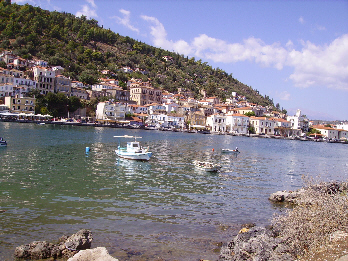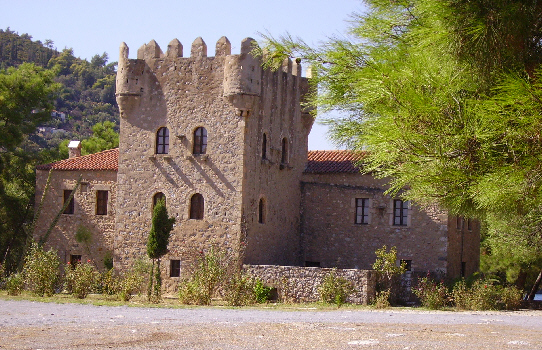Journey through Ancient Greece
Yithio
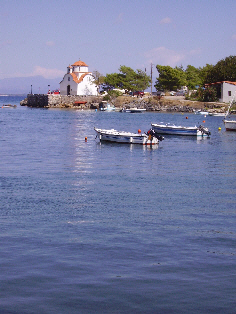
Kranai island where Helen & Paris spent their first night together
The small town of Ythio is built into the hillside of Mount Koumaros and around a pretty waterfront, with the snow capped Tayetos mountains towering above on the horizon. Flights of stone steps, or scalas, lead at intervals up the hill between the buildings; you will get happily lost wandering amongst the elegant eighteenth and nineteenth century neo-classical houses, many with balconies and blue wooden shutters.It is the largest town in the Mani, and the main port of Lakonia. There are boats of all sizes in the harbour: small painted fishing boats and caiques, large commercial ships, ferries to Piraeus and the islands and cruise ships the size of multi story car parks.
Yithio is now a popular tourist resort, but primarily with Greeks and particularly, Athenians; the mass package holiday market has not yet reached here so most of the foreign tourists are independent travellers.
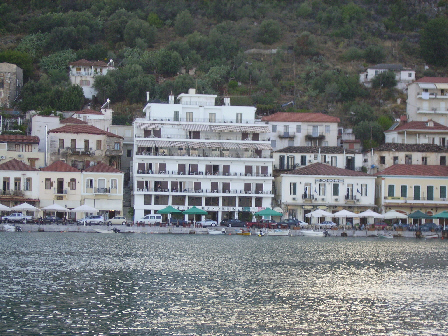
The Hotel Pantheon where we will be staying
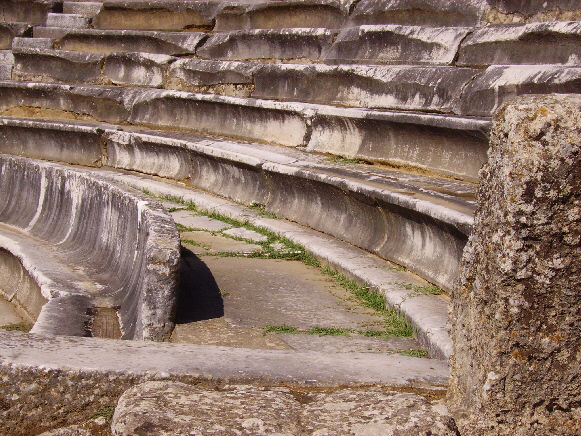
The little Roman theatre - the seats are really comfortable
The most prominent landmark is the picturesque island of Kranai, also known as Marathoni (fennel island) and since 1896 joined to the mainland by a causeway. This tiny island is where Helen and Paris stopped on their way from Sparta to Troy and spent their first night together: Ythio was famous for its murex, sea shells which produce the much coveted purple dye, much used for royal garments. According to Pausanius the Lakonian coast has the best sea shells in the world, excepting only the Phoenician sea.'' Vol 2. The island is covered in pine trees and surrounded by volcanic rock (Kranai means rocky or craggy); it is a peaceful place for a stroll or a picnic, visiting the small church, the museum and the lighthouse.The Museum of the Tzannetakis tower on the island The three storied tower was built by Zanetbey Tzannetis Grigorakis, a general of the War of Independence. On the ground floor there is an exhibition of the history of the Mani according to travellers from the 16th to 20th centuries, many foreign; most of them didn't actually set foot in the region, but their writings, drawings and photographs tell an interesting story of this turbulent and fascinating region. On the first floor are pictures and plans of typical Mani tower houses. If you are awake early you will see the sun rise over the island.
The long waterfront of Yithio sweeps around the bay and is divided into three sections. The middle part, Akti Vasileos Pavlou, is the harbour and where our hotel, the Pantheon, is situated. Here there are several tavernas, cafes and shops. On the harbour wall is a fine statue of a sailor, a memorial to those lost at sea and beyond that a bronze mermaid, the significance of which I didn't work out, but it is rather nice.
Beyond this, to the north, the road divides in two either side of a lovely small park , known as Perivlaki , in which is the Town Hall, a fine neo-classical building designed by Schiller which contains a small, not very exciting, archaeological museum. In the park and overlooking the sea are some cafe including the Touristik Pereptero bar/cafe, a good place for coffee and sticky cakes or beer and mezes. The promenade continues along the waterfront. (If you look towards the bay in the distance you can see the wreck of a ship, I've never been able to find out how or when it got there.) The inland road leads to the modern town which we haven't fully explored but doesn't look very exciting.
There is a chemist, photographer and just beyond the park a largish supermarket, Kourtakis. Going the other way, south past the hotel, there is another small square, Plateia Mavromihali where there are several bars, fast food places and tavernas as well as a small supermarket. Continuing round the port towards Kranai (Marathoni) the road, called Kranais , is lined with more tavernas.
As far as we can see Yithio is not a great shopping temptation apart from an excellent bookshop and an Aladdin's cave of an antique shop, both on Akti Vasileos Pavlou, near our hotel. The latter specialises in enormous old farm and kitchen implements (not terribly easy to get home!). The bookshop is run by Yiorgos Hassanakos , an artist whose paintings of the region are available as post cards and whose marvellous Karaghozia puppets line the walls. He has produced and sells a to the town, and a superb book on the Mani lavishly illustrated with his own photographs. On Tuesday morning there is a market in Ermou at the northern end of the harbour.
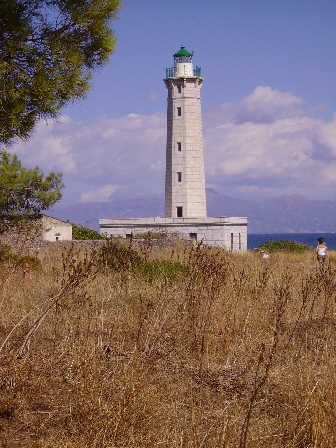
The lighthouse on Kranai Island
